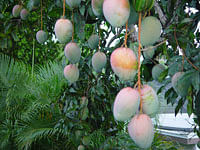
In a startling revelation at a fruit and vegetable summit last May, P K Mishra, secretary in the ministry’s department of agriculture, said “Seventy-two per cent of India’s fruit and vegetable produce goes waste” due to “lack of proper retailing and adequate storage capacity.”
India is the second largest producer of fruits and vegetables in the world. Of the 370 million tonnes of fruits harvested globally, India accounts for 30 million tonnes. It is the world’s largest producer of mangoes and bananas; a significant player in the cultivation of pineapple and oranges besides a wide range of tropical and other fruits. Overall fruit production has been consistently notching up impressive growth year after year despite New Delhi’s avowed emphasis on the foodgrain sector.
These achievements on the farm front are heartening as fruit is a key component of a healthy, balanced diet. But for some reason, the per capita consumption of it remains abysmal.
On a commercial note, very little of fruit is exported either as fresh or as a processed commodity. In the absence of adequate processing and refrigeration/storage/cold chain facilities, the situation is made worse by callous and antiquated post-harvesting practices, a staggering quantity of the produce rots in the fields or dangerously decays while in the process of transportation, storage and in the last leg of reaching the consumer.
Rather than benefiting households, children, the sick and the needy by way of an easily available and reasonably priced tasty nutritional supplement, and giving the growers a remunerative income, much of the highly perishable farm produce rapidly loses value as it ripens and starts deteriorating. The value of this wastage is estimated at a whopping Rs 20,000 to Rs 50,000 crore annually. Worse, the pile up of the putrefying mass at assorted places becomes a breeding ground for disease and pests, and poses a major challenge to the municipal authorities charged with keeping the civic areas clean.
Generating fruity energy: The developed world has a pointer or two for better management of fruit waste. In the USA, huge amounts of ageing farm produce such as bananas, watermelons and other sugar-rich fruit that have external blemishes or deformities or for some reason are not market worthy, are often ‘thrashed by burying them in fields’. Now in a stroke of genius, rather than burying the problem, technology has made it possible to convert the decomposing fruit into an essential commodity, a renewable resource — bio-fuel to power vehicles, heat homes and for cooking, to name some uses.
Dual purpose
“All fruits are 10 per cent sugar, or potentially five per cent ethanol,” affirms Elliot Altman, an engineer from the Centre for Molecular Bio-engineering, University of Georgia. Besides creating bio-energy, the end product of the fermentation process is a high-protein byproduct that can serve as animal feed.
Ethanol fuel has long been seen as a clean, alternative fuel to petrol. In that epicentre of greens movement in San Francisco, a billion gallons of ethanol has been put into motorised vehicles, without anyone really noticing. The use of ethanol in internal combustion engines, either alone or in combination with other fuels, has environmental and long-term economical advantages over fossil fuel.
It is worth noting that an US government regulation mandates the blending of five per cent ethanol into gasoline by 2009 and 10 per cent by 2011. The Renewable Fuel Standard programme plans to increase the volume of renewable fuel required to be blended into gasoline from nine billion gallons in 2008 to 36 billion gallons by 2022. However, the fly in the ointment is the cost. Ethanol plants don’t come cheap. They require significant investment. To be cost effective, experts argue that a project would need to produce at least 10 million gallons of ethanol a year.
Meanwhile, to enlarge ethanol usage at affordable rates, much is happening on techniques and processes to simplify the commercial ethanol production plant. The raw inputs presently are largely corn, sorghum or sugarcane — the usage of which for fuel as against use as food has stirred a hornet’s net. However in the heated debate, American researchers have hit upon a novel idea: using decaying fruit to make ethanol.
These developments could not have come at a better time for India. Even as we struggle for infrastructure, post-harvesting, refrigeration and related solutions for farm produce, the year-round supply of large quantities of rotting fruit, currently a major disposal problem can well be turned on its head. The decomposing and offending item can well be converted into ethanol. Plants set up strategically at points of high fruit production may well reduce the heavy dependence on imported petroleum.